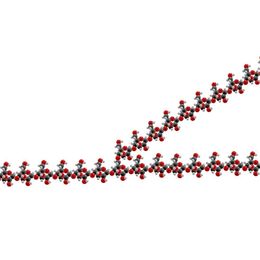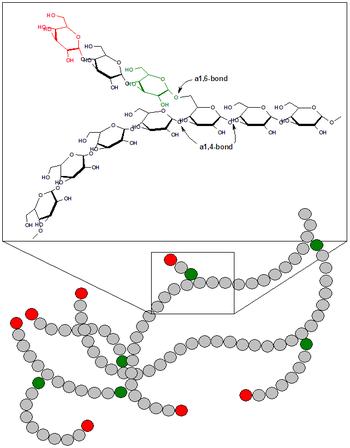گليكوجن

گليكوجين بالإنجليزية Glycogen هو بوليمر متعدد الوحدات يشكل الجلوكوز وحدة البناء الاساسية في هذا الجزئ، ويعمل كمخزن للطاقة في الحيوانات والفطريات. ترتبط كل وحدة جلوكوز مع الوحدة التي تليها بروابط من نوع الفا 1-4 في حين تتكون التفرعات من روابط 1-6، عندما تقل نسبة الجلوكوز في الدم تبدأ عملية تحطيم الجلايكوجين إلى الوحدات الاساسية المكونة له وهي الجلوكوز، في حين تتم عملية عكسية لتحوبل جزيئات الجلوكوز إلى جلايكوجين عندما ترتفع نسبة الجلوكوز في الدم.
الإنتاج
ينتج الكبد الجليكوجين الذي يخزن في جسم الإنسان في الأماكن التالية: الثلث منه يختزن في الكبد ويتم إفرازه عند اللزوم أما الكمية المتبقية والتي تمثل الثلثين تختزن في خلايا العضلات ويستفاد من معظمها عند آداء التمارين الرياضية. لذلك يعتبر الجليكوجين مصدر هام للطاقة.
البناء والكيمياء الحيوية
Glycogen is a highly branched polymer that is better described as a dendrimer of about 60,000 glucose residues and has a molecular weight between 106 and 107 daltons (~4.8 million).[بحاجة لمصدر] Most of Glc units are linked by α-1,4 glycosidic bonds, approximately 1 in 12 Glc residues also makes -1,6 glycosidic bond with a second Glc, which results in the creation of a branch. Glycogen does not possess a reducing end: the 'reducing end' glucose residue is not free but is covalently bound to a protein termed glycogenin as a beta-linkage to a surface tyrosine residue. Glycogenin is a glycosyltransferase and occurs as a dimer in the core of glycogen. The glycogen granules contain both glycogen and the enzymes of glycogen synthesis (glycogenesis) and degradation (glycogenolysis). The enzymes are nested between the outer branches of the glycogen molecules and act on the non-reducing ends. Therefore, the many non-reducing end-branches of glycogen facilitate its rapid synthesis and catabolism.
الجليكوجين وتنظيم وظيفة الكبد
As a meal containing carbohydrates is eaten and digested, blood glucose levels rise, and the pancreas secretes insulin. Glucose from the portal vein enters the liver cells (hepatocytes). Insulin acts on the hepatocytes to stimulate the action of several enzymes, including glycogen synthase. Glucose molecules are added to the chains of glycogen as long as both insulin and glucose remain plentiful. In this postprandial or "fed" state, the liver takes in more glucose from the blood than it releases.
After a meal has been digested and glucose levels begin to fall, insulin secretion is reduced, and glycogen synthesis stops. About four hours after a meal[بحاجة لمصدر], glycogen begins to be broken down and converted again to glucose. Glycogen phosphorylase is the primary enzyme of glycogen breakdown. For the next 8–12 hours, glucose derived from liver glycogen will be the primary source of blood glucose to be used by the rest of the body for fuel.
Glucagon is another hormone produced by the pancreas, which in many respects serves as a counter-signal to insulin. When the blood sugar begins to fall below normal, glucagon is secreted in increasing amounts. It stimulates glycogen breakdown into glucose even when insulin levels are abnormally high.
في العضلات والخلايا الأخرى
يعتبر جليكوجين العضلات بمثابة مركز إحتياطي للجلوكوز المتاح لخلايا العضلات. تحتوي الخلايا الأخرى على نسب صغير تستخدمها عضويا. تفتقد خلايا العضلات إنزيم جلوكوز سداسي الفوسفات ، لذلك فهي تفتقد القدرة على تمرير الجلوكوز للدم ، وبالتالي فإن وظيفة الجليكوجين المختزن داخلها هو أنه يستعمل الجلوكوز الإحتياطي لديه ويستخدم فقط للإستعمالات الخارجية ولا يشارك فيه خلايا أخرى غير خلايا الكبد.
نقص الگليكوجن وتدريب التحمل
Due to the body's inability to hold more than around 2,000 kcal of glycogen,[بحاجة لمصدر] long-distance athletes such as marathon runners, cross-country skiers, and cyclists go into glycogen debt, where almost all of the athlete's glycogen stores are depleted after long periods of exertion without enough energy consumption. This phenomenon is referred to as "hitting the wall" or "bonking". In marathon runners it normally happens around the 20 mile (32 km) point of a marathon, where around 100 kcal are spent per mile,[بحاجة لمصدر] depending on the size of the runner and the race course. However, it can be delayed by a carbohydrate loading before the task.
When experiencing glycogen debt, athletes often experience extreme fatigue to the point that it is difficult to move.
إضطرابات التمثيل الغذائي للجليكوجين
The most common disease in which glycogen metabolism becomes abnormal is diabetes, in which, because of abnormal amounts of insulin, liver glycogen can be abnormally accumulated or depleted. Restoration of normal glucose metabolism usually normalizes glycogen metabolism as well.
In hypoglycemia caused by excessive insulin, liver glycogen levels are high, but the high insulin level prevents the glycogenolysis necessary to maintain normal blood sugar levels. Glucagon is a common treatment for this type of hypoglycemia.
Various inborn errors of metabolism are caused by deficiencies of enzymes necessary for glycogen synthesis or breakdown. These are collectively referred to as glycogen storage diseases.
التوافق
مقال رئيسي:الجليكوجينات
التكسير
مقال رئيسي: Glycogenolysis
انظر أيضا
وصلات خارجية
المصادر
- ^ William D. McArdle; Frank I. Katch; Victor L. Katch (2006). Exercise physiology: energy, nutrition, and human performance (6 ed.). Lippincott Williams & Wilkins. p. 12. ISBN 978-0-7817-4990-9.



